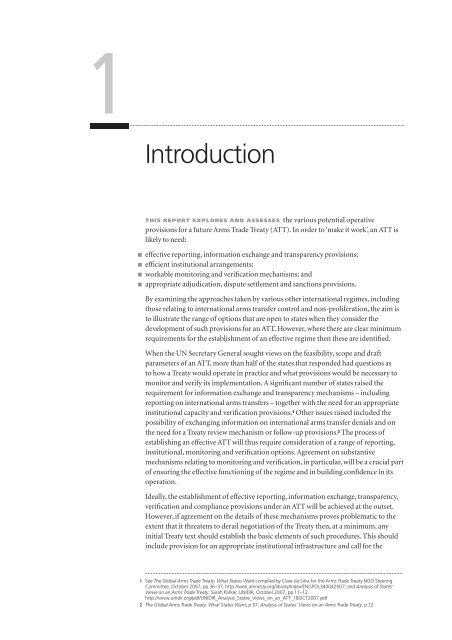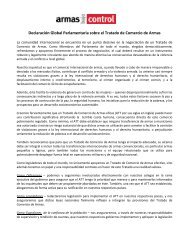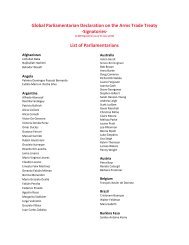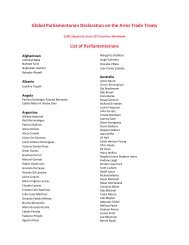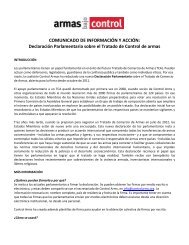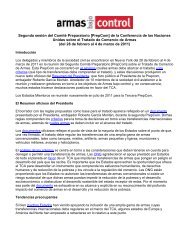Making it Work - Control Arms
Making it Work - Control Arms
Making it Work - Control Arms
- No tags were found...
Create successful ePaper yourself
Turn your PDF publications into a flip-book with our unique Google optimized e-Paper software.
1IntroductionTHIS REPORT EXPLORES AND ASSESSES the various potential operativeprovisions for a future <strong>Arms</strong> Trade Treaty (ATT). In order to ‘make <strong>it</strong> work’, an ATT islikely to need:■ effective reporting, information exchange and transparency provisions;■ efficient inst<strong>it</strong>utional arrangements;■ workable mon<strong>it</strong>oring and verification mechanisms; and■ appropriate adjudication, dispute settlement and sanctions provisions.By examining the approaches taken by various other international regimes, includingthose relating to international arms transfer control and non-proliferation, the aim isto illustrate the range of options that are open to states when they consider thedevelopment of such provisions for an ATT. However, where there are clear minimumrequirements for the establishment of an effective regime then these are identified.When the UN Secretary General sought views on the feasibil<strong>it</strong>y, scope and draftparameters of an ATT, more than half of the states that responded had questions asto how a Treaty would operate in practice and what provisions would be necessary tomon<strong>it</strong>or and verify <strong>it</strong>s implementation. A significant number of states raised therequirement for information exchange and transparency mechanisms – includingreporting on international arms transfers – together w<strong>it</strong>h the need for an appropriateinst<strong>it</strong>utional capac<strong>it</strong>y and verification provisions. 1 Other issues raised included thepossibil<strong>it</strong>y of exchanging information on international arms transfer denials and onthe need for a Treaty review mechanism or follow-up provisions. 2 The process ofestablishing an effective ATT will thus require consideration of a range of reporting,inst<strong>it</strong>utional, mon<strong>it</strong>oring and verification options. Agreement on substantivemechanisms relating to mon<strong>it</strong>oring and verification, in particular, will be a crucial partof ensuring the effective functioning of the regime and in building confidence in <strong>it</strong>soperation.Ideally, the establishment of effective reporting, information exchange, transparency,verification and compliance provisions under an ATT will be achieved at the outset.However, if agreement on the details of these mechanisms proves problematic to theextent that <strong>it</strong> threatens to derail negotiation of the Treaty then, at a minimum, anyin<strong>it</strong>ial Treaty text should establish the basic elements of such procedures. This shouldinclude provision for an appropriate inst<strong>it</strong>utional infrastructure and call for the1 See The Global <strong>Arms</strong> Trade Treaty: What States Want compiled by Clare da Silva for the <strong>Arms</strong> Trade Treaty NGO SteeringComm<strong>it</strong>tee, October 2007, pp 36–37. http://web.amnesty.org/library/Index/ENGPOL340042007; and Analysis of States’Views on an <strong>Arms</strong> Trade Treaty, Sarah Parker, UNIDIR, October 2007, pp 11–12.http://www.unidir.org/pdf/UNIDIR_Analysis_States_Views_on_an_ATT_18OCT2007.pdf2 The Global <strong>Arms</strong> Trade Treaty: What States Want, p 37; Analysis of States’ Views on an <strong>Arms</strong> Trade Treaty, p 12


